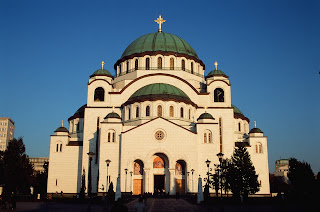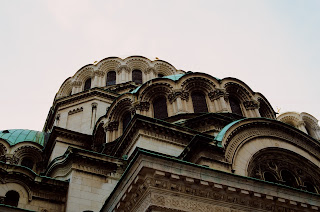Although I know with absolute certainty that nobody, not even Chinese spambots, persists in checking this site for updates, I am going to update it again anyway.
Starting with an attempt to upload a lot of photos for which I will give no context or explanation until some future date, I am going to give some basic update and over view of the last 6 weeks or so.
In my constant attempts to become a hipster, I brought a 38 year old 35mm film camera so I could pretend to be a tourist from 1973 instead of a tourist from 2011. I remember using a film camera when I was a kid, although it was a much more highly automated machine than this old Nikon. The experience of taking photos whose results will remain a mystery for quite some time is a huge adjustment from digital. If I screw up a digital shot, I erase it and retake on the spot. If I screw up a film shot, I've lost the opportunity completely. The lag between exposure and development for some of my photos was almost exactly 2 months. Needless to say, getting the film back was quite a rush. The entire time it was at the lab I was covertly worrying about the quality of the staff at the store-- "What if they screw up all 5 rolls?"
Perhaps it's this emotional and chronological knot that makes me feel more strongly for my film work than my digital stuff - but I have found, of the 180-odd photos, a much higher probability of what I'd consider a "very good" shot (at least for my skill level). With the film results, I am proud enough of perhaps 25-30 of the 180 to share them. Of course about 40 are abysmal or worse. But with digital, I can (and in the past have been to known to) snap 600-1000 photos in a single day. Out of that mind boggling number, I'll end up with 25-30 I am proud enough of to share. On a great day, with the right subject, maybe I'll get 100. But that still leaves my "hit" percentage at between 2.5-10% with digital, and at around 20-30% for film.
Of course there are a dozen reasons for that. Digital cameras do everything for you, making it easy to run through a place with the shutter button held down, snapping a photo of everything that moves and a lot of things that don't. With a fully manual camera and lens combo, combined with film's time lag, each shot is a commitment. I have to stop, focus the lens, read the meter, decide what range of apertures I have available given the light, and then decide if I think the meter is giving me information for the kind of shot I want to take.
The end result is this: the idiot-proof modern digital camera actually creates idiot-shots. The completely cumbersome and anachronistic film camera forces me to pay enough attention to my photos to get good results. It's really quite amazing.
This is a complaint I have read in a few places, mainly those writing about the transition from film to digital. Anyone who started out with film cameras instinctively thinks that the best thing about digital is the ability to take as many photos as you want for FREE! It's an incredible breakthrough (especially when I just paid more than $10 per roll just to develop film, in Croatia). And the symptoms of mid-life transition between film and digital are easy to see in someone like me. Of course I was young when that happened, but I was certainly old enough to have wasted a lot of money on film and developing (rather, lots of mom and dad's money). One of the first things I thought of, even when I was 8 years old, was "holy cow, it's free to see the pictures and it's instant!" The first digital camera I saw in person used 3.5" floppy disks as memory. I remember thinking about how cheap they were compared to film...
Anyway, the photos I'll be posting are all scans from film. The black and white I'll post are conversions from color film scans.
I hope you enjoy the photos as much as I have enjoyed taking them. Perhaps they'll do a better job of describing the places I am passing through than any words I can hammer into a keyboard.
Above: Zagreb Kaptol Cathedral exterior wall, Croatia.
Zagreb Cemetary on All Saint's Day, Croatia
Zagreb Kaptol Cathedral, Croatia
Random Austro-Hungarian style door in Belgrade, Serbia
Belgrade (Beograd) Central Train Station, Serbia
Archangel Gabriel church near the Partizan Football Stadium, Belgrade, Serbia
Belgrade Central Railway Station Platform, Serbia
Alexander Nevsky Cathedral, Sofia, Bulgaria
Wall beside a road in Štrpce.
Men playing chess in Kalmegdan Park, Belgrade, Serbia.
Zagreb Cemetary, Croatia
Zagreb Cemetary, Croatia
Zagreb Cemetary main gate, Croatia
Zagreb Cemetary wall, exterior, Croatia
Zagreb Kaptol Cathedral outer wall, Croatia
Zagreb Kaptol Cathedral outer wall, Croatia
Fountain, Kalmegdan Park, Belgrade, Serbia
Men playing chess in Kalmegdan Park, Belgrade, Serbia
Gavrilo Princip graffiti, near Belgrade Central Train Station, Serbia
Fire Salamander, near Štrpce, Kosovo.
Belgrade Central Railway Station platform, Serbia
Serbian Train (Zheleznitse Srbije) at Belgrade Central Railway Station, Serbia
Sofia Synagogue, Sofia, Bulgaria
Red Star Football Club graffiti, Belgrade, Serbia
Saint Sava Temple, Belgrade, Serbia
Austro-Hungarian style doorway, Belgrade, Serbia
Belgrade Central Railway Station, Serbia
Alexander Nevsky Cathedral, Sofia, Bulgaria
Alexander Nevsky Cathedral, Sofia, Bulgaria.
Alexander Nevsky Cathedral, Sofia, Bulgaria
View from my apartment window, Štrpce, Kosovo.
Another view from my apartment window, Štrpce, Kosovo.
Orthodox church (left) next to Mosque (right), Ferizaj/ Uroševac, Kosovo
View from my coffee cup, Štrpce, Kosovo.
Mountains between Prizren, Kosovo and Štrpce, Kosovo.
Mosque and river in Prizren, Kosovo.
Another view from my apartment window, Štrpce, Kosovo.
Zagreb Kaptol Cathedral façade, Croatia
Zagreb Kaptol Cathedral façade and candle sellers, All Saints' Day, Croatia
Zagreb Kaptol Cathedral façade, Croatia
All Saint's Day Procession, Zagreb, Croatia
Danube and Sava river confluence, Belgrade, Serbia.
Archangel Gabriel church, Belgrade, Serbia
Inside Archangel Gabriel church, Belgrade, Serbia
Unfinished/ Abandoned Orthodox Cathedral, Prishtina/ Priština, Kosovo
Trail and wall near Štrpce, Kosovo
Abandoned structure in a pasture, Mount Sharr/ Šar, Štrpce, Kosovo

































































